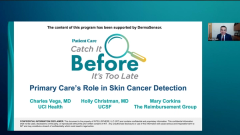
Real-World Impact: Patient Case Examples of AI Skin Checks
Panelists discuss an interactive case session emphasizing the nuanced evaluation of suspicious skin lesions, highlighting tools such as the DermaSensor for risk scoring, the ugly duckling concept, and the importance of combining clinical judgment with technology to guide biopsy decisions and patient follow-up across diverse skin types.
Episodes in this series

This section highlights an interactive case discussion that brings real-world dermatology diagnosis into focus. The cases presented involve evaluating suspicious skin lesions, emphasizing how subtle details can be crucial in dermatologic assessments. The importance of closely examining features such as texture, borders, color, and overall appearance is stressed, as these elements often guide clinical judgment. The concept of the ugly duckling lesion—one that stands out compared to surrounding moles—is introduced as a practical tool for identifying potentially concerning growths. These cases show that no single feature alone confirms malignancy; rather, it’s a combination of clinical findings and careful observation that informs the next steps.
Using diagnostic tools such as the DermaSensor can aid in this process by providing numerical scores that indicate the likelihood of malignancy. High scores, such as a9, strongly suggest biopsy and further evaluation, while moderate scores require careful clinical judgment. The tool offers flexibility, allowing providers to consider follow-up rather than immediate biopsy when results are ambiguous. This balance acknowledges the complexity of skin cancer diagnosis and avoids placing undue legal or clinical pressure on practitioners. The cases also underline that skin cancer can affect individuals with a wide range of skin types, reinforcing the need for vigilance regardless of complexion.
The final cases demonstrate that certain lesions may appear more benign but still warrant monitoring, with advice to patients to report any changes promptly. Scores that fall into an intermediate range suggest the need to investigate further, which may involve closer follow-up or additional diagnostic steps. Melanomas can present differently from basal or squamous cell carcinomas, requiring awareness of their unique characteristics. Overall, this case-based approach underscores the combination of clinical skill, technology, and patient education necessary for effective skin cancer detection and management in primary care settings.
Newsletter
Enhance your clinical practice with the Patient Care newsletter, offering the latest evidence-based guidelines, diagnostic insights, and treatment strategies for primary care physicians.













































































































































































































































































